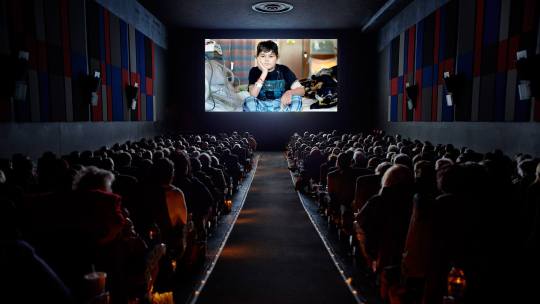Business of Art | Traditional Distribution vs. Service Deals and Hybrid Options
Filmmakers, you have the power to choose the best distribution model for your film.
In a January 2018 event held at New York Foundation for the Arts (NYFA), Jim Browne of Argot Pictures weighed the advantages and potential disadvantages of various distribution options for filmmakers considering theatrical releases in North America. From the marketing phase, to promotion, booking, and the film’s overall revenue goals, filmmakers have the option to choose traditional distribution or to take on service deals or hybrid options.
Read on to learn more about each option, as well as which factors to consider when choosing the distribution model that is best for your film. This event was presented by NYFA Fiscal Sponsorship, a program that enhances the fundraising capabilities of individual artists and artist-run organizations, in partnership with NYFA Learning.
Traditional Distribution
A traditional distribution deal is arranged by a distributor that acquires the rights to your film.
Traditional distribution deals are highly coveted in the sense that the market is competitive, and they do not come around often. If you are offered a deal, however, make sure that you accept the deal’s terms. It’s great to have the interest of distributors, but it’s also important to make the decision that is best for your film. Here are some potential benefits and drawbacks for this model:
Pros
- Simplicity: You won’t have to pay out-of-pocket for the distribution of your film. The distributor also takes care of the marketing, outreach, promotion, and booking of the film with a high amount of expertise. The distributor can give your film access to a general audience, or a niche audience that the distributor has had success with in the past.
- Advances: A typical deal will include a monetary advance.
- Guarantees: You are provided a set of guarantees for the film. For example, the distributor will stipulate that they will have your film shown at x amount of theaters and will spend y amount on advertising and publicity.
- Time: With distribution responsibilities taken care of by your distributor, you are free to move on to your next creative endeavor.
Cons
- Delayed or Negative Income: Although you do not have to contribute your own money into the distribution phase, it may take time to earn back what you’ve put into the film or to make a profit. The distributor’s focus is on advertisements, so more often than not, the advance gained at the beginning of the contract will be the only money you will see at the end. If publicity is most important to you, then this may not matter as much. You may also be able to set spending benchmarks in the contract with your distributor to prevent negative income.
- Less Creative Control: Once you hand over the rights of your film to the distributor, you may lose creative control. You may be left out of the equation when the trailer or key art for the film is created. A good way to maintain power over your film is to negotiate shorter term contracts and offer renewals based on achieved benchmarks.
- Lack of Transparency: You may not always know where the funding is going or why. Reporting for your film may also follow an uncertain or prolonged timeline that could be quarterly or even once a year.
- A Surplus of Films: The digital age makes it easier to have your film available to the public more quickly and cheaply, but the amount of films out there grows exponentially by the day. The market is competitive.
Next Steps After You are Offered a Deal: Ask Questions!
1. When you receive that first offer for traditional distribution, do due diligence and ask these initial questions:
- Who has worked at the company?
- Which filmmakers has the company worked with in the last few years?
- How were others’ experiences with the company?
2. Consult with a lawyer you trust or an experienced producer who has recently sold films.
3. Check your ego! A lot of hype can come with securing traditional distribution, but it doesn’t guarantee that your film will be a smash hit. Sometimes, though, your own expectations as an artist may diverge from what your film brings to the public, as well as the realities of the marketplace. The distributor may decide to show the film in less theaters, for example, or target different audiences than the ones you originally had in mind.
Service Deals and Hybrid Options
Service deals take place when an experienced film distribution professional works for a fee rather than a percentage of the revenue that is made by the film.
Hybrid releases are semi-theatrical models for film showings. As opposed to a traditional theatrical model, you strive to gain as many full theatrical runs as you can, but also run them as one-off showings.
If a traditional distribution deal was not offered to you, you did not like the terms of the deals you were offered, or you want to be more involved in the film’s life from production to distribution, you should consider theatrical releases through service deals and hybrid options. All rights to the film would be retained by you. Keep the following pros and cons in mind as you weigh these options.
Pros
- A Closer Relationship with Your Audience: If your film engages with a social issue or if you are targeting a niche audience, small community-based screenings might work well for your film. Service deals and hybrid releases are most effective in making these happen.
- Creative Control: You maintain creative control of your project and the film rights remain with you. One of the joys of filmmaking is its collaborative process, and, with these models, you are able to choose your collaborators from distributors to publicity, marketing, and outreach consultants and designers. You can participate in developing your film’s marketing strategy and craft a unique audience engagement strategy.
- Possibility of More Revenue: Although you are paying out-of-pocket for the expenses of distribution, it may be possible to earn more revenue on your film, as there is no percentage shared with a distributor. These funds will go directly to you. For small independent releases, having your film gross over $50,000 is a success!
Cons
- Out of Pocket Expenses: The funds you will be using for this leg will need to be out of pocket, and you will need to be ready to fundraise, whether it is through crowdfunding, grants, individual donations, or investment.
- Time: This route will require more personal investment as it takes time to put together a distribution plan. You will not be able to move on to your next project as swiftly.
- A Surplus of Films: Just as with the traditional distribution model, the market is competitive. Keep this in mind if you are going to be investing a great deal of your own time and money.
More Tips To Consider for Service Deals and Hybrid Releases
- Consider what the short-term and long-term goals of the film are, and put together a strategic distribution plan with those in mind.
- Trust the experiences of your distribution consultant and collaborators, and trust that they are doing good work. All consultants who do this believe in interesting films and want your film to make its way to the right audiences.
- Always ask for references for the collaborators you work with and have conversations with them. Articulate what your intentions are and consider what they can bring to the table on behalf of your film.
- Manage your expectations: think about how a viewer goes to the movies. They may love the concept of your film and be excited to see it, but they do not always schedule their time around that. Do not be disappointed if viewers do not show up to a slew of screenings happening in just a week.
Jim Browne has been exhibiting, programming, producing, and distributing film projects in New York for over 25 years. He founded Argot Pictures, an independent film company specializing in hybrid-distribution strategies for documentaries and feature films, in 2006. Browne, the former Director of Theatrical Distribution for Plexifilm, served as a programmer for the Tribeca Film Festival from 2006-2010 and the North American programmer for the Abu Dhabi Film Festival from 2010-2014. He is currently the American consultant for the Shanghai International Film Festival. He is based in Brooklyn, NY.
– Priscilla Son, Program Assistant, Fiscal Sponsorship & Finance
Are you an artist or a new organization interested in expanding your fundraising capacity through NYFA Fiscal Sponsorship? We accept out-of-cycle reviews year-round. No-fee applications are accepted on a quarterly basis and our next deadline is March 31. Click here to learn more about the program and to apply.
Sign up for NYFA’s free bi-weekly newsletter to receive updates on future programs, and check out NYFA’s Business of Art Directory to read more articles on this topic and others.
Image: José on-screen at the E. 86th Street Theater, 2017, Defining Hope, Carolyn Jones (Sponsored Project), Photographer: Jaka Vinsek





